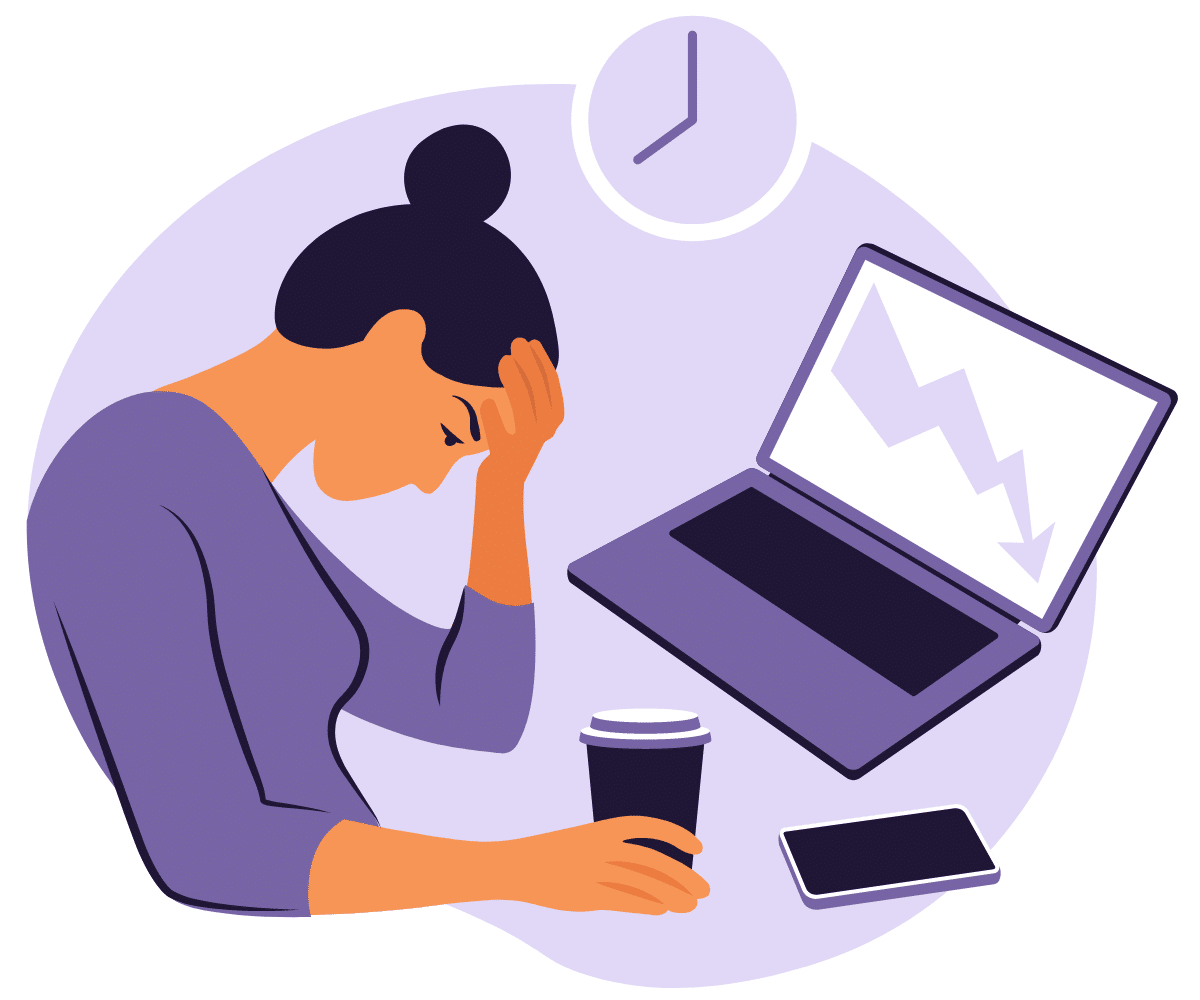Are you feeling exhausted all the time and feel trapped or defeated? If so, you may be suffering from burnout. In 2019, ‘burnout’ was recognised by the World Health Organisation (WHO) as an ‘occupational phenomenon’ resulting from chronic workplace stress that has not been successfully managed, whether this is due to long-term stress in your job, or when you have worked in a physically or emotionally draining role for a long time, such as caring for patients. WHO has identified three main characteristics of the syndrome: firstly, the feelings of energy depletion or exhaustion. Secondly, increased mental distance from one’s job, or feelings of negativism or cynicism related to one’s job, and lastly reduced professional efficacy.

Global studies have found that as many as two in five IT professionals are at high risk of burnout and as many as 42% of women were consistently burned out at work, compared to 35% of men. This is also more likely to lead to employees leaving their jobs and developing mental or physical problems. Therefore, it is important to understand its causes, signs and how to prevent it.
Signs/symptoms:
Although WHO has classified three characteristics of burnout, there are more signs and symptoms to be on the lookout for. This can include feeling inadequate in your role and as though you are failing, even though you are trying hard. This may come from having a negative or cynical outlook leading to feeling like no matter what you do, it won’t be good enough or make a difference. Other common symptoms are constantly feeling overwhelmed and procrastinating or generally taking longer to get tasks done. A reason for this can be that it’s harder to sustain your attention and ignore distractions during this time. A 2015 study on the brain during burnout backed up this idea. It showed that, compared to a control group, an overworked group had weaker connections between two brain structures (the amygdala and the mesial prefrontal cortex), one being critical in emotional reactions including fear and aggression. The impairment of the ability to suppress negative emotions in subjects suffering from occupational stress may lead to them being more vulnerable to depressive symptoms. The overworked group also reported feeling more stressed than their counterparts and, if this persists, can lead to burnout.
However, it is important to note that burnout is not the same as stress. Whilst stress can occur daily for most, there is a feeling of there being an end in sight, and isn’t likely to affect all aspects of your life. For example, you can leave your work problems at work. Moreover, with stress, you’re unlikely to have an overarching sense of hopelessness, loneliness intense negative feelings and lowered immunity to illness. A significant factor that relates to burnout and less so for stress is the feeling of complete exhaustion and the amount of time these feelings persist for.
You can find out more about dealing with stress and finding a good work-life balance here.
5 stages of burnout:
As discussed, burnout occurs over a long period of time, it doesn’t have a quick onset like stress might. Therefore, 5 phases leading up to burnout have been identified, which can be really handy to know so you can spot them in yourself or people around you. You may not even notice the initial phases, or they may feel like nothing. However, it is important to still try to recognise them as this is what can lead to problem later.
- Honeymoon phase
This phase is in the early days of starting a new job or a new task, when you might be feeling lots of energy and a positive attitude to your work. This can lead to you having high productivity levels.
- Onset of stress phase
At some point the honeymoon phase will start to wear off and the stress starts to kick in. This may be due to increased responsibilities after being eased into the job/task or just starting to lose the focus and interest you had in something starting new. This won’t involve feeling constant stress yet, but fatigue might be starting to set in.
- Chronic stress phase
At some point this stress will become more persistent, or chronic. As this starts to happen, it is likely your performance at work will start to suffer as a result, causing more feelings of stress. You may also start to withdraw socially and have a short fuse with co-workers or friends and family at home.
- Burnout phase
This is when you reach your limit and can no longer function as you normally would. You may go on to experience extreme self-doubt and feel numb. You start to obsess over your problems at work so much so that it takes over your home and work life and even your health. Physical symptoms will be evident, including chronic headaches and gastrointestinal problems.
- Habitual burnout phase
If you don’t find a way to manage the fourth phase, it can become a part of your everyday life and ultimately lead to anxiety and/or depression. At this point, you may end up losing your employment and/or have lasting mental and physical health problems.
These phases show why it is so important to try to be in tune with any mental or physical changes you may feel, so you can catch them early on and not end up with burnout.
Factors that can impact burnout:
There are some common factors that can lead to burnout, including a poor work-life balance or work overload. This may include working overtime or companies expecting too much work of its employees in the given working hours. Occasionally working over your usual hours or doing extra work usually won’t have too much of an impact, but if this repeatedly happens and the person feels they are unable to catch up or feels defeated regularly this can lead to a burnout.
Unclear job descriptions can also lead to stress which, if this continues can cause someone to constantly feel like they aren’t doing a good enough job or doing more than what they originally thought they were going to be doing. You may also be unsure about the degree of authority you have and so are either stepping over your boundary and creating animosity within your team. Alternatively, you may not be asserting enough authority and so are being taken advantage of by doing more work/hours than you should by doing others work.
A lack of social support within the workplace can also lead to burnout. If you feel like there isn’t anyone to talk to, this can be very isolating and can mean you take on all your problems yourself and may mean you are afraid to ask for help. Whereas, if you have support, they may be able to help with your workload and offer advice. Even just talking about your worries has been proven in some studies to release pent-up and negative feelings.
You may also have a dysfunctional workplace which can contribute to work stress. For example, you might have an office bully, or you feel undermined by colleagues, or your boss micromanages your work which will put off you even coming into the office or make you on high alert throughout every day, waiting for something bad to happen. This is also an issue that you can easily take home with you and cause distress outside of work hours, creating problems in your general day-to-day life. If you have a boss that doesn’t value your work and you receive insufficient rewards, you are also less like to want to do your work or feel it is adequate. This will lead to a lack of morale and motivation.
How to avoid it/rebound from it:
There are some ways you can help avoid burnout and help yourself overcome it. Firstly, it is important to set boundaries in your work life. This may be making sure you only work within your set working hours, don’t take work home with you (unless working from home!) and knowing when to say no to taking on more work if it is going to have a detrimental effect to your mental health. You should also be taking breaks during your work day to reset and make sure your stress levels don’t get too high. Moreover, taking days off work helps promote a good work-life balance and to see friends and family so you maintain a positive support system.
Having good support systems where you can share your feelings/worries with is vital to keeping a positive state of mind. Employee networks are a great tool to help create an inclusive work environment. They are voluntary groups of colleagues with similar beliefs, backgrounds or interests. They provide support, advice, or just a sounding board in a safe, confidential environment. Employee networks can help give employees a strong sense of belonging and offer an opportunity for people to connect with other like-minded employees.
There are also some general lifestyle changes you can make that will benefits you mentally and physically and ultimately will help improve your work life. For example, having a good diet, making sure you exercise and get enough sleep. National Library of Medicine’s study has shown that insufficient sleep, preoccupation with thoughts of work during leisure time, and high work demands are risk factors for subsequent burnout.
How employers can help:
It is important for both employees and employers to recognise the signs leading up to burnout and try to tackle it before it causes further issues, but to also know how to avoid it and rebound from it if it does occur. If an employees’ mental and physical health is good, they will be more likely to bring their best selves to work and be motivated to work hard. This is supported by a study by Asana which looked at 10,000 workers across seven countries and found that when they were experiencing burnout, they were also more likely to have lower morale (36% of people), be less engaged (30%), make more mistakes (27%) and miscommunicate (25%). In fact, they were even more likely to leave the company (25%).
A way companies can help is to have clear job descriptions when people are entering a new job or role so employees know what will be expected of them. Also ensure that once they are in the role, these tasks do not get added to unless they have had a conversation about it prior to being given the extra work and make sure they are happy with this. Although it is also good to be aware of how much extra work they are taking on and whether it is possible to achieve in the normal working hours and they are not repeatedly having to work overtime as will contribute to a poor work-life balance.
Also, regular catchups with a manager or supervisor are vital to ensure the workload is ok for the employee and they are happy at work. They are also valuable because they offer the employee time to speak to someone one-on-one and raise any issues or concerns they are having in a quiet and supportive setting. As previously mentioned, even just sharing your worries can dramatically help a person’s outlook and put them at ease. Also this is a good time to broach any sensitive subjects, such as any bullying or discrimination they’re facing or anything personal they are going through that may affect them at work, such as menopause or pregnancy loss. This then creates an opportunity for the senior member of staff to offer any help or guide them to where they can find support, for example NHS’s Wellbeing Service.
As an employer it is also good for employees to have mentors or role models who they can look up to and also ask questions to if they are unsure about anything. Mentors can also provide support and give advice from personal experiences and help manage stress and concerns. In addition, having Employee network groups gives employees opportunities to build support systems which can help reduce stress and anxiety.
Ask yourself these questions and if you feel like you may be suffering from burnout, speak to your employer to see how they can help.
- Am I part of the process?
- Do I get along with my co-workers?
- Do I enjoy the work I do?
- Is there enough support?
- Is there a work-life balance?
- Are there growth opportunities?
You can read tips on self-care for women in tech here.






